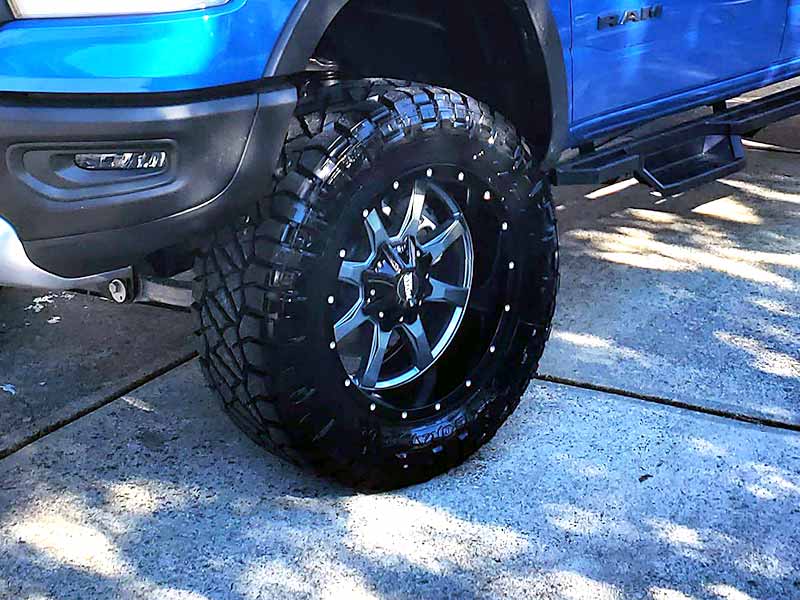Imagine you’re gearing up for a new set of tires for your car or truck. You come across terms like ‘285/65/20′ or ’35-inch tire’, and you’re left wondering what these numbers actually mean in the real world. It’s a common scenario for many vehicle owners, and understanding these numbers can be the difference between a smooth ride and a not-so-great fit.
What Size Is A 35 Inch Tire On A 20 Inch Rim?
A tire with a height of 35 inches can be achieved through various tire sizes on a 20-inch rim. Common sizes include 285/65R20, 295/60R20, and 275/70R20. Each of these combinations results in a tire with an overall diameter close to 35 inches, suitable for a 20-inch wheel.
In this article, you will gain insights into tire size notation, learn how to calculate the total diameter of a tire, understand what a 35-inch tire actually means, and how to choose the right tire size for your vehicle.

Tire Sizes By Height Calculator
Understanding Tire Size Notation
When you’re looking to understand what a 35-inch tire on a 20-inch rim really means, it’s crucial to start with the basics. So, let’s talk tire sizes. You’ve probably seen something like 285/65/20 stamped on the side of a tire and wondered what these numbers actually indicate. Don’t worry, it’s not as cryptic as it seems!
The Magic Trio: Width, Aspect Ratio, and Rim Diameter
- Width in Millimeters (First Number)
- The first number (e.g., 285) represents the width of the tire in millimeters. This is the distance from one side of the tire to the other, measured across the tread. In our example, the tire is 285 millimeters wide. It’s all about how much tire is in contact with the road.
- Aspect Ratio (Second Number)
- The second number is the aspect ratio, and in our case, it’s 65. This isn’t just a random number; it’s actually a percentage. It tells you how the height of the tire’s sidewall (the side part of the tire) compares to the width. So, a 65 aspect ratio means the sidewall height is 65% of the tire’s width. Thicker sidewalls can mean a smoother ride, as they absorb more of the bumps.
- Rim Diameter in Inches (Third Number)
- Lastly, the 20 in 285/65/20 refers to the diameter of the rim in inches. This is the size of the wheel that the tire is designed to fit. In our example, this tire is made for a 20-inch rim. It’s all about making sure the tire and wheel fit together perfectly.
Why Isn’t the Total Diameter Directly Mentioned?
Now, you might be wondering, “Where’s the total diameter in all of this?” The thing is, standard tire size notation doesn’t directly tell you the total diameter of the tire. It gives you the pieces of the puzzle, but you have to put them together to see the full picture.
Speedometer Error Calculator
Calculating the Total Diameter of the Tire
Alright, let’s roll up our sleeves and get into the nitty-gritty of calculating the total diameter of your tire. It’s not just a useful skill; understanding this can help you make informed choices about your tires, ensuring they not only fit your vehicle but also suit your driving needs.
Step-by-Step Guide to Tire Diameter Calculation
- Calculate the Sidewall Height
- First, let’s find out the height of the tire’s sidewall. Remember our aspect ratio? That’s where it comes into play.
- Here’s the formula: Sidewall height = Width of the tire × Aspect ratio.
- For our example tire (285/65/20), it would be 285 mm × 0.65.
- Convert to Inches
- Since we’re dealing with a mix of metric and imperial units (millimeters and inches), let’s convert the sidewall height to inches for consistency. There are 25.4 millimeters in an inch.
- So, the sidewall height in inches = (Sidewall height in mm) / 25.4.
- Add the Rim Diameter
- Now, take the sidewall height in inches, and remember, there are two sidewalls (top and bottom) adding to the total diameter.
- Total tire diameter = Sidewall height (in inches) × 2 + Rim diameter.
- For our tire, this means doubling the sidewall height we calculated and then adding the 20 inches of the rim diameter.
Example Calculation with 285/65/20
Let’s crunch the numbers for our example tire:
- Sidewall Height Calculation
- 285 mm × 0.65 = 185.25 mm.
- Convert to inches: 185.25 mm ÷ 25.4 ≈ 7.29 inches.
- Total Diameter Calculation
- Sidewall height × 2 + Rim diameter = 7.29 inches × 2 + 20 inches.
- Total diameter ≈ 7.29 inches + 7.29 inches + 20 inches = 34.58 inches.
So, a 285/65/20 tire is approximately 34.58 inches in diameter, which is pretty close to what we call a “35-inch tire.” This example shows why it’s always good to do the math – the names we give tires are often rounded up for simplicity.
Practical Implications
Understanding this calculation is more than just a party trick for car enthusiasts. It’s essential for:
- Ensuring proper clearance in your wheel well.
- Maintaining accurate speedometer readings.
- Keeping your vehicle’s handling characteristics optimal.

What Does a 35-Inch Tire Mean?
Now that we’ve tackled the math behind tire sizes, let’s zoom in on what we mean when we refer to a “35-inch tire.” This term is more than just a measurement; it’s a key to understanding how your tire fits and performs on your vehicle.
- Total Diameter, Not Just a Number
- A “35-inch tire” generally refers to the total outer diameter of the tire – from the ground to the top of the tire when it’s mounted on a wheel.
- This measurement gives you a quick idea of how big the tire is overall, which is crucial for things like ground clearance and fitting the tire in the wheel well.
- Not Always Exactly 35 Inches
- Here’s something important: the term “35-inch tire” is often a rounded figure. The actual diameter might be slightly more or less than 35 inches.
- For example, our earlier calculation showed that a 285/65/20 tire is approximately 34.58 inches in diameter, which is close enough to be considered a “35-inch tire” in common parlance.
Understanding the Relationship to Standard Size Notation
- Connecting to the 285/65/20 Format
- The standard size notation (like 285/65/20) and the “35-inch” label are two sides of the same coin.
- The notation gives you specific dimensions (width, aspect ratio, rim size), while the “35-inch” label gives you a ballpark idea of the tire’s overall height.
- Knowing both helps you make more informed decisions about tire choices and understand how they’ll affect your vehicle’s performance and appearance.
Why This Matters
- Fit and Function
- Selecting a tire with the correct diameter is crucial for ensuring it fits your vehicle without issues like rubbing against the wheel well.
- It also impacts how your vehicle handles, rides, and even how the speedometer reads.
- Upgrading or Modifying Your Vehicle
- If you’re looking to upgrade or modify your vehicle, understanding tire sizes is key. Whether you’re aiming for a certain look or a specific off-road capability, knowing what a “35-inch tire” really means in terms of size helps you make choices that align with your goals.

Choosing the Right Tire for Your Vehicle
Selecting the right tire size isn’t just about aesthetics; it’s a crucial decision that affects your vehicle’s performance, safety, and overall driving experience. Let’s navigate through the key considerations to ensure you make the best choice for your vehicle.
Matching Tire Size to Vehicle Specifications
- Consult Your Vehicle’s Manual
- The first step is always to check your vehicle’s manual. Manufacturers specify the ideal tire size for each model, considering factors like load capacity, power output, and overall vehicle dynamics.
- Sticking to these recommendations is usually the safest bet for maintaining optimal performance and safety.
- Understand the Impact on Performance
- Changing tire size can affect various aspects of vehicle performance:
- Handling: Larger tires may offer better grip, but can also make steering heavier.
- Acceleration and Speedometer Accuracy: Larger tires can throw off speedometer readings and affect acceleration.
- Fuel Efficiency: Incorrect tire size can lead to reduced fuel efficiency.
- Changing tire size can affect various aspects of vehicle performance:
- Safety Considerations
- Using tires that are too large or too small for your vehicle can compromise safety:
- Braking: The wrong size can affect braking efficiency.
- Suspension and Alignment: Incorrect tire sizes can put extra strain on suspension components and affect alignment.
- Using tires that are too large or too small for your vehicle can compromise safety:
Tips for Selecting the Right Size
- When in Doubt, Stick to the Manufacturer’s Recommendations
- While it’s tempting to go for a different look or feel, it’s generally safest to stick with the size that your vehicle was designed to use.
- Consider Your Driving Needs
- If you’re contemplating a size change, consider why. Are you looking for better off-road capability, or are you aiming for a certain aesthetic? Make sure the benefits outweigh the potential downsides.
- Seek Professional Advice
- If you’re unsure, it’s always a good idea to consult with a tire professional. They can provide insights specific to your vehicle and driving habits.
A Word on Upgrades and Modifications
- For those looking to modify their vehicle (like installing lift kits or custom wheels):
- Remember that any change in tire size might require additional modifications to ensure proper fit and function.
- Always consider the full scope of changes needed to maintain a safe and enjoyable driving experience.
Resources
Below are some links you may find helpful when learning about tires:
- Tire size equivalent chart for 33″, 35″, 37″ or 40″ tires – Tire Buyer
- Are 35 inch tires right for your rig? – Milestar Tires
Final Thoughts
This article has walked you through the basics of tire size notation, the method to calculate the total diameter of a tire, and the practical considerations when choosing a tire size.
By now, you should feel more confident in deciphering tire sizes and making informed decisions about the tires that best suit your vehicle’s needs.
Remember, the right tire size is not just about dimensions; it’s about the overall harmony of your vehicle’s performance, safety, and aesthetics.
Good luck and happy motoring.





